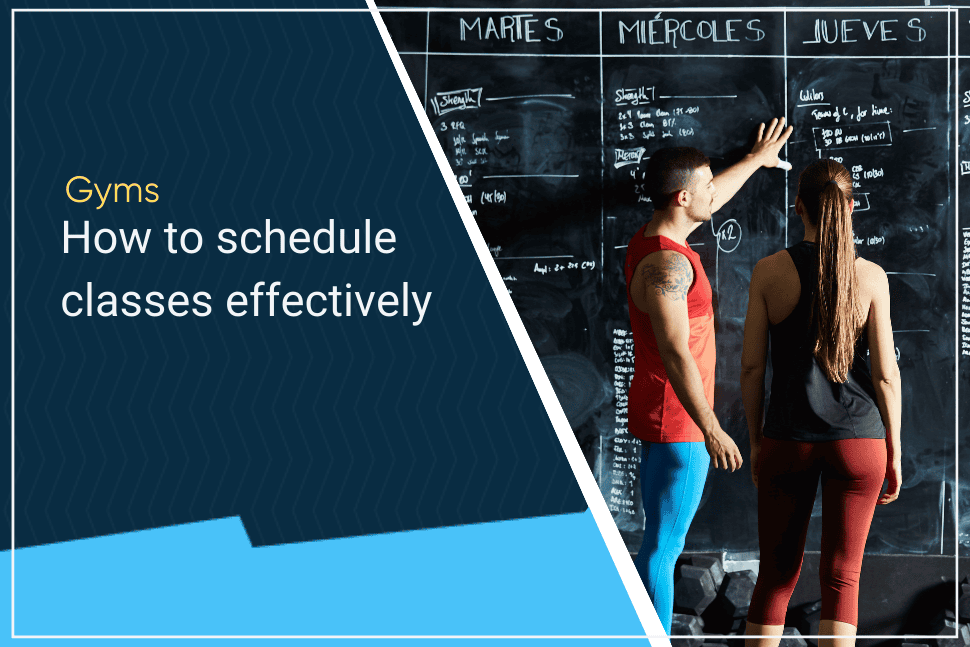How to Schedule Gym Classes Efficiently

Local gym manager Sarah found herself staring at her computer, scrolling through a class schedule that never seemed to work. No matter how she tried changing times and the class offerings, some slots were under-booked, while others had too many students. Members complained about their favorite classes being offered at inconvenient times, and attendance appeared to ebb and flow without good reason. Sarah was stuck in trial and error, not knowing whether she was putting on too many classes or not enough.
Sarah hadn’t taken the time to evaluate the schedule thoughtfully. She was always putting out fires instead of stopping them. If she could know the peak times, track attendance trends, and manage class offerings based on member preferences, she knew she could generate a schedule that would work for everyone, and lead to member success.
If you're a gym manager like Sarah, this article will help you master your schedules. By applying what follows, you'll harness the power of peak optimization, member needs, and data-driven planning to schedules that boost attendance and results.
Understanding Peak Times: When to Schedule for Maximum Attendance
- Analyze Member Traffic: Knowing when your members are most likely to attend classes is important to maximize participation and help your gym run smoothly. Member traffic varies by time of day. Peak attendance varies as well, depending on work schedules, fitness goals, and personal habits. Once you start to identify these patterns, you can adjust your class schedule accordingly to be demand-driven so that you can fill your classes without stressing your staff or your gym. Understanding peak times starts with tracking when members take your classes. Today’s gym software is extremely data-rich, offering tons of information that can provide you with real-time insights into your members’ attendance behaviors. Most top gym management platforms automatically track attendance and generate reports outlining the best-attended classes/times, instructor popularity, and member demographics (e.g., age groups, etc.). If your gym isn’t already using some sort of software, you might want to think about implementing it just to be able to collect valuable information on attendance trends. Beyond using software, running member surveys can afford you more fine-grained insights. You can check which times members prefer to attend classes, and the most convenient days of the week when members think classes will be most suitable. You can also learn what types of classes members are most interested in and at what specific times of day.
- Weekday vs. Weekend: On weekdays, students tend to arrive at similar times, while the weekend attendance could be drastically different. Weekday attendance tends to peak during early morning (before work), lunchtime (midday), and early evening (post-work). The precise times, though, will differ depending on your gym’s members’ demographics.
- Time of Day: Early morning classes (6:00 AM – 8:00 AM) are in high demand for most gyms. Early morning tends to be a popular time for members who work out before work (i.e., commuters or early risers). Classes in the middle of the day tend to see a peak as well, specifically the lunch hour classes (12:00 PM – 1:00 PM) as many members with flexible work schedules or who are looking to squeeze in a quick workout during their lunch break can help fill these classes. Peak hours are scheduled for evening classes (5:30 PM – 7:30 PM), when the majority of people hit the gym after finishing their workday. Attendance patterns shift on weekends. Most gyms have lower attendance Saturday and Sunday early in the morning and during the midday. But late mornings (9:00 AM – 12:00 PM) and early afternoons (1:00 PM – 3:00 PM) generally experience more turnout, especially for classes that are more social or group-based. Attendance may further decrease on weekends, as many members choose to enjoy their weekend, rather than attend classes. By identifying these patterns, gym managers will know the peak hours to schedule key classes as well as support staff level adjustments. A spin class, for instance, could be popular at 6:00 AM, while a yoga class may attract more members at 10:00 AM on a Saturday.
- Holiday and Seasonal Adjustments: Seasonal factors, such as holidays or summer recess, also affect member retention. Knowledge of these seasonal changes allows managers to adjust the schedule according to fluctuations in attendance so as to prevent staff from wasting time and waiting around for customers during the slow periods.Attendance is low on major holidays (Christmas, New Year, Labor Day, etc.) if members travel and/or spend time with family. New Year’s Eve is not without its last-minute gymgoers, though, who might flock to the gym in the weeks leading up to the holiday season in preparation for New Year’s resolutions. Attendance usually drops during summer due to holidays and mass interest in outdoor activities. On the contrary, the beginning of the school year (August to September) mostly means everyone is back to his or her gym schedule and this can lead to a spike in the membership. To account for these changes, plan on being flexible with your hours because of holiday shifts. Offer fewer classes or adjusted class times during large holidays but add promos or special events to draw people in! (Provide time-limited classes or incentives to keep members engaged during seasonal lulls as well.Identifying Member Preferences and Needs
- Conducting Member Surveys: Surveys provide a firsthand view of the specific kinds of classes members like and at what times. In asking for express feedback from members, the club can pinpoint where your current schedule might be falling short, or it can simply capture the data to allow patterns to emerge over time that would aid in advising how to choose classes for maximum appeal. Surveys should not take long: You want them to be short, to-the-point, and focused on relevant things like when they like to work out, which formats, and satisfaction with the current offering. Some questions are broad — like “What time do you prefer to work out?” —while others are more specific, like “What type of class do you think is missing from our current schedule?" You might also ask members about their fitness goals and how those could affect their class preferences. For instance, people interested in weight loss may prefer high-intensity classes, while members focused on flexibility or stress relief may choose yoga or Pilates. Offer discounts, free access to classes/class passes, or entry into a prize to encourage participation. Conducting regular surveys, quarterly or even biannually, can identify changing preferences and double-check that your schedule continues to line up with what members want
- Demographic Considerations:Not every member has the same fitness needs, or even the same goals. Knowing the segments of the demographic of your gym is essential to customize your class schedules in order to make it appealing and effective. People of various ages, fitness levels, and personal ambitions have their own timings and class types they prefer to engage in.For instance, Gen Zers and millennials in their 20s and 30s may be drawn to high-intensity offerings, such as high intensity interval training (HIIT), spin, or boot camp classes, and typically prefer evening workouts after 9-to-5, or early morning before their day starts. Members in their 40s and 50s might look for lower-impact classes like yoga, Pilates, or strength during midday, when they can use a more flexible schedule. Older adults, who may be less keen on a vigorous workout plan, might choose classes like water aerobics, stretching, or chair yoga. By providing a mix of class types at times that fit each demographic’s wants and needs, you can offer a schedule that appeals to all. Also, consider special needs in your gym. For example, if the clientele for your groups are working parents, they might prefer early morning or evening classes, whereas those with more flexibility in their schedule (e.g. working from home) might be more likely to make it to a mid-morning or early afternoon session. If you want parents to participate, consider providing programs that accommodate their needs, such as before or after-school sessions, kids' classes, or even childcare services. Your schedule should also be guided by your members' fitness goals. Members primarily interested in losing weight may lean toward fast-paced, calorie-burning aerobic exercises like spin or boot camp, while members adding or toning muscle may choose strength training, kettlebell, and functional fitness classes.
- Balancing Popular vs. Niche Classes: At any gym, certain high-demand classes are going to appeal to a large portion of your member base. Classes like yoga, spin, or Zumba, for example, draw a lot of people, and can be the foundation of your routine. But you must also supplement their offering with niche or specialty classes that may cater to smaller but equally committed segments of your membership. Classes that focus on a specific niche, like kickboxing, Pilates, barre, or TRX can offer your gym a distinct value. These classes may not count the drop-in visitors that yoga or spin do, but they allow members to dabble in other types of fitness and foster loyalty among those who feel strongly about certain types of worout. Adding niche classes to your timetable also helps you stand out from the crowd and provides something different that caters to a range of interests and fitness levels. It is important to keep in mind to fit these popular and niche classes in time slots that suit both. Popular classes are frequently scheduled at peak hours—early mornings, lunch breaks and early evenings—when attendance is at its highest. Niche classes, meanwhile, might be best scheduled during off-peak hours, like mid-morning or late evening, when you’ll have more scheduling freedom in terms of instructor access and studio availability. You can also consider bundling niche classes or selling them as a complement to your popular options, such as a yoga and a strength-building class bundled a balanced wellness combo.To get it right, keep a close eye on attendance data and members’ feedback. Some niche classes start to gain traction and can be considered for prime time slots. On the flip side, trending classes may need to be trimmed if interest falls off or if they conflict time-wise with newer and more attractive alternatives. Optimizing Class Duration and FrequencyThe duration of a class is an important factor in its effectiveness and attractiveness. While most classes are either 45-minute or 60-minute, shorter or longer workouts can be advantageous based on the type of class and the needs of your members.
- 45-minute classes: Benefit high-intensity workouts like HIIT, spin, and circuit training as those classes offer a full body workout in a quicker time frame. These classes work well for busy professionals who prefer fast, effective sessions.
- 60-minute classes: Typical for strength workouts, yoga, Pilates, and functional fitness sessions that need extra time for proper warm-up, technique, and cooldown.
- 30-minute express classes: Ideal for lunchtime workouts or supplementing regular gym classes before or after. They’re great for core-focused workouts, stretching, or beginner classes. Providing a variety of class durations ensures that all members have something they can work into their schedule. For example, shorter express sessions during high-demand times (e.g., lunch breaks) as opposed to longer, more immersive classes during off-peak hours may balance attendance.Balancing Class FrequencyHow frequently you run a class also depends on demand and instructor and gym capacity. A balanced schedule keeps the members and instructors from burning out while providing variety and engagement. For example, high-demand classes (such as spin, yoga, and HIIT) should be held multiple days a week to fit different schedules. Some popular choices may even have daily availability, particularly during rush hours.
- High-demand classes (e.g., spin, yoga, HIIT) should be offered multiple times per week to accommodate different schedules. Popular options may even be scheduled daily, especially during peak hours.
- Specialized or niche classes (e.g., barre, kickboxing, TRX) can be scheduled 1-3 times per week to maintain interest without overloading the schedule. These classes may require more commitment from members, so spacing them out helps with consistency.
- Progressive classes (e.g., strength training programs, mobility workshops) may follow a structured schedule, such as twice a week, to allow for recovery and gradual progression.
- Stagger start times: If two classes cater to similar demographics, such as a strength class and a HIIT class, stagger them out 15-30 minutes apart so members can transition.
- Diversify class types during peak hours: Rather than running two high-intensity classes at the same time, schedule one strength-focused class and one mobility-based class to target unique needs.Tracking Attendance and TrendsGym managers must harness data to monitor attendance patterns in order to ensure efficient class utilization. Gym management software allows for easier monitoring of class popularity, peak times when people attend, and cancellation rates. This information can show clearly if a certain class is consistently oversubbed or underperforming, guiding the scheduling process. Member feedback, via surveys or app-based reviews, is also instrumental in pinpointing which classes connect best with the gym’s clientele.Use this data to tailor the schedule to better engage appearing members. As an example: If HIIT classes are particularly popular amongst participants in the mornings, increasing the number of sessions you offer at those times can lead to better attendance overall. On the other hand, underperforming classes might require changes to the timing, format or instructor to garner more participants.Automation and ToolsModern scheduling software takes the hassle out of gym timetables, allowing for easy organization. Tools such as Gymdesk offer automated scheduling that minimizes human error and enable real-time updates. These platforms also offer automated reminders for members, which minimizes no-shows and same-day cancellations. Another benefit of automation is that instructor availability can be managed smoothly. If a member has to cancel, software can send instant notifications to members and recommend make-up sessions, enabling member satisfaction and loyalty.Maximizing Instructor Availability and EfficiencyA well-structured schedule isn’t only about when classes are scheduled; it also depends on the right instructors being available at the right times. Poor instructor choices cause poor attendance and member dissatisfaction. Here’s how gym managers can make the most out of instructor availability.
Matching Instructor Strengths with Types of Classes
Every instructor has their own strengths, whether it be leading high-energy spin classes, technical weightlifting sessions or zen yoga flows. Members will benefit immensely when all instructors teach within their expertise.
- Assess Instructor Skill Sets: Evaluate your team’s strengths and qualifications. Make sure your instructors are leading classes where they excel and have strong engagement with members.
- Avoid Overloading Instructors: Overbooking an instructor for multiple back-to-back sessions can lead to burnout and lower energy levels, which may affect the quality of the class.
- Offer Cross-Training Opportunities: Encourage instructors to become certified in multiple class formats to increase scheduling flexibility.Balancing Prime and Off-Peak HoursSince peak hours demand a higher level of energy and crowd management, scheduling your most experienced instructors during these times ensures that classes run smoothly. Meanwhile, newer instructors can gain experience by leading classes in off-peak hours.
- Peak Hours: Assign your most popular and experienced instructors to classes held in the early morning, lunch, and evening slots when attendance is highest.
- Off-Peak Hours: Use this time for specialty or niche classes, training new instructors, or offering workshops for smaller, more dedicated groups.
- Instructor Rotation: If an instructor consistently teaches at peak hours, rotate their schedule occasionally to prevent burnout and give members a fresh perspective with a different instructor.
- Develop a Substitution System: Have a list of backup instructors who can step in on short notice.
- Cross-Train Staff: Train front desk staff or trainers in basic fitness instruction so they can lead modified classes if an instructor is unavailable.
- Offer Virtual Backup Classes: In cases where no substitute is available, consider offering a virtual or pre-recorded class to avoid cancellations.
- Monthly and Quarterly Reviews: Analyze attendance reports to identify shifts in member preferences.
- Phasing Out Low-Performing Classes: If a class consistently underperforms, consider replacing it with a trending or member-requested format.
- Expanding Popular Classes: If a class is frequently at full capacity, consider adding another session or increasing the class size.
- Seasonal Offerings: Consider offering outdoor classes during warmer months or special holiday-themed classes.
- Short-Term Challenges: Create limited-time class series, such as an 8-week strength training boot camp, to attract both new and existing members.
- Hybrid and Virtual Options: Many members enjoy the flexibility of online workouts. Offering a mix of in-person and virtual classes caters to different preferences and schedules.The key to an effective gym class schedule is flexibility. Even after tracking attendance and collecting data, schedules must remain adaptable. For instance, if a class unexpectedly becomes more popular, you may need to adjust instructor schedules or add more classes at certain times. Similarly, if a niche class is struggling to attract attendees, consider offering a promotional event or limited-time discounts to boost interest.Regularly assess the performance of classes and be prepared to change your strategy to optimize results. Flexibility ensures that your gym can continually evolve based on member preferences, attendance patterns, and emerging trends.
Refining Class Offerings Based on Data Insights
Once you’ve collected enough data, use it to evaluate which types of classes are consistently under-booked. This insight helps you decide whether a class time should be adjusted, a class should be removed, or a new offering should be introduced to meet member demand. For example, if a 7:00 AM HIIT class consistently fills up, but an afternoon class remains under-attended, consider shifting the afternoon class to a more suitable time or replacing it with a different class type that might appeal to members during those hours.
Additionally, consider offering classes based on the seasonality of attendance. During periods when attendance tends to dip—like summer or major holidays—take advantage of this downtime to introduce special or niche classes. These classes might not bring in as many members, but they can help keep loyal customers engaged and attract new members with unique offerings.
Ensuring Flexibility for Ongoing Success
The key to an effective gym class schedule is flexibility. Even after tracking attendance and collecting data, schedules must remain adaptable. For instance, if a class unexpectedly becomes more popular, you may need to adjust instructor schedules or add more classes at certain times. Similarly, if a niche class is struggling to attract attendees, consider offering a promotional event or limited-time discounts to boost interest.
Regularly assess the performance of classes and be prepared to change your strategy to optimize results. Flexibility ensures that your gym can continually evolve based on member preferences, attendance patterns, and emerging trends.
Conclusion
An efficient and thoughtful class schedule is more than just about timing—it's about understanding your members' needs and behaviors.
By analyzing attendance data, leveraging member feedback, and refining your schedule accordingly, you can create a class lineup that maximizes participation, fosters member loyalty, and contributes to the overall success of your gym.
Remember: scheduling is an ongoing process, and the more you track, adjust, and adapt, the better your results will be. Keep listening to your members and leveraging data for continuous improvement to stay ahead of the curve.
Gym management software that frees up your time and helps you grow.
Simplified billing, enrollment, student management, and marketing features that help you grow your gym or martial arts school.





